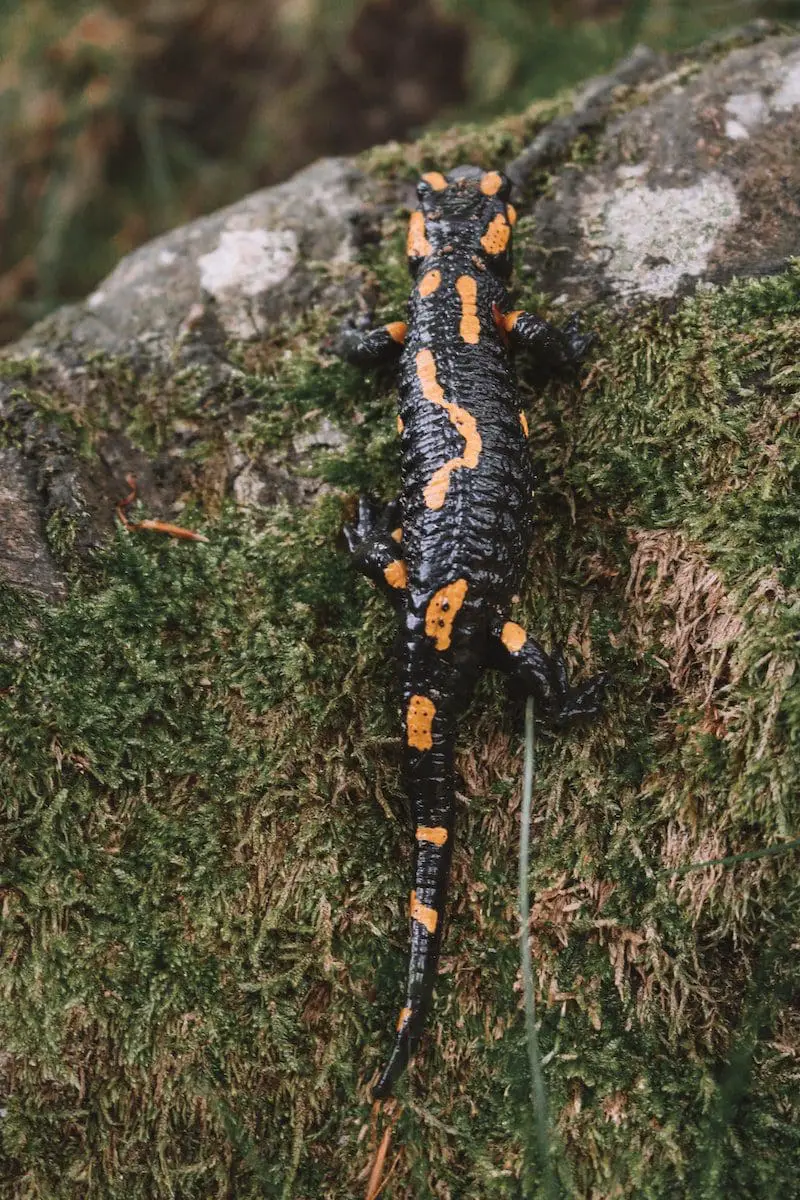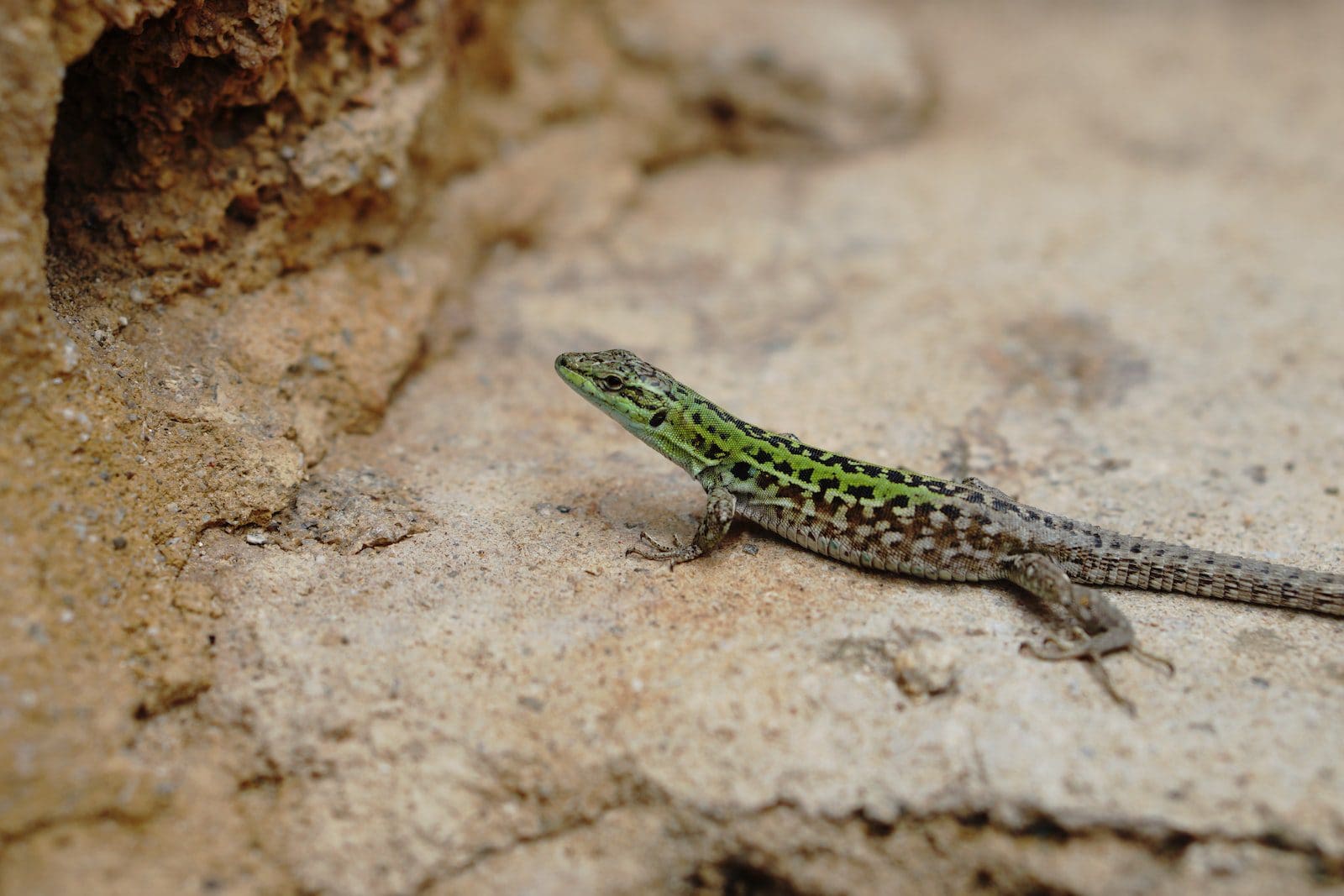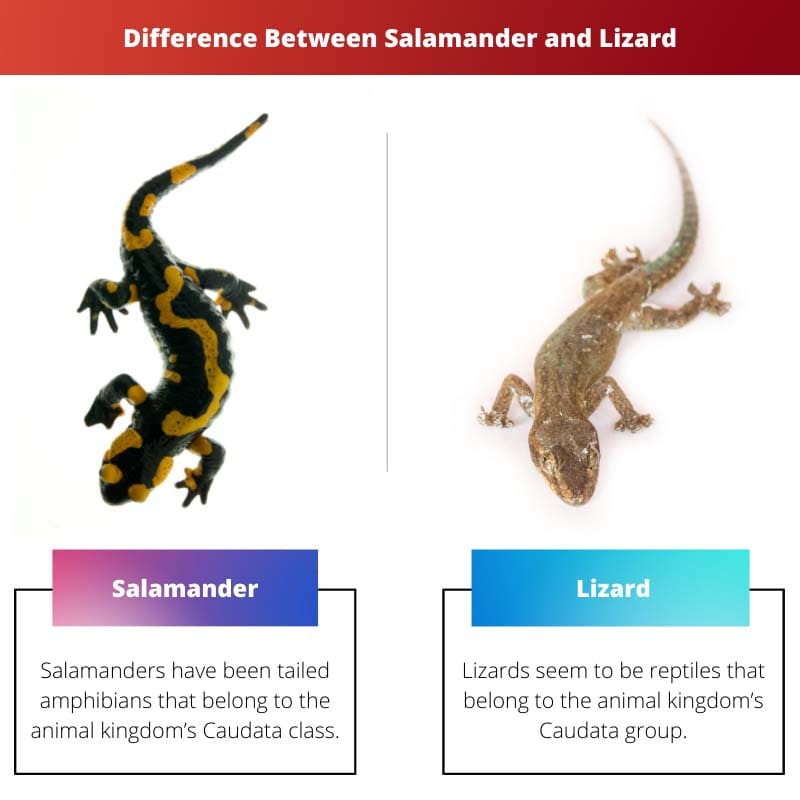The bodies of lizards and salamanders are primitive tetrapods. They feature long tails with slim bodies. Many salamanders, like some other lizards, have missing or shortened limbs, giving them an eel-like image. The lizard versus salamander analogy can be quite useful in distinguishing fact from opinion. One ‘ll be able to determine which method is best for each creature in this manner.
Key Takeaways
- Salamanders are amphibians with smooth, moist skin and no scales, while lizards are reptiles with dry, scaly skin.
- Salamanders undergo a metamorphosis from aquatic larvae to terrestrial or semi-aquatic adults, while lizards hatch from eggs and do not undergo a significant metamorphosis.
- Salamanders use their tails and body undulations for locomotion, while lizards rely on their legs and exhibit greater agility in various terrains.
Salamander vs Lizard
The difference between a salamander and a lizard is that the former’s body is wet and non-scaly, whilst the lizard’s body surface is hard and scaly. Salamanders have small feet, while lizards have bigger feet. Every salamander’s limb has 4 fingers with 5 toes. Each limb of a lizard has 5 fingers with five toes. Youngsters are fond of both salamanders as well as lizards being pets.

Salamanders are amphibians belonging to the family Caudata inside the animal kingdom’s category Amphibia. Approximately 160 million years ago, they certainly emerged on this planet. Salamanders are primarily widespread in North and South America and the cold regions, including Northern Asia, Africa, and Europe. There are around 600 varieties of salamanders currently.
Lizards seem to be reptiles that pertain to the category Caudata, which is part of the Reptilia class. There are almost 6000 different species of lizards in the globe. The tiniest lizard is now the gecko, as well as the largest lizard, seems to be the Komodo monitor.
Comparison Table
| Parameters of Comparison | Salamander | Lizard |
|---|---|---|
| Class and Group | Salamanders have been tailed amphibians that belong to the animal kingdom’s Caudata class. | Lizards seem to be reptiles that belong to the animal kingdom’s Caudata group. |
| Living Standards | Salamanders need wet living standards, which is why they are frequently seen near bodies of water. | On the other hand, Lizards can also be found in a variety of environmental situations, including damp, hot, dry, and so on. |
| Hatched in | Salamanders are hatched in water or mushy terrain and also have gills for breathing. Adults inhale and exhale through their lungs. | Lizards are birthed on the surface of the earth and breathe through their lungs. |
| Life Cycle | Salamanders change form, such as from tadpole to adults. | On the other hand, Lizards don’t go through the metamorphosis; when they get hatched, the offspring look exactly resemble their parents. |
| Defensive Capability | To defend themselves from predation, Salamanders employ the fluids of their skin glands. | Lizards defend themselves against predators by biting, utilizing a sharp spine, and shredding their tail. |
What is Salamander?
Salamanders have wet, scaleless skins and therefore are tailed amphibians. Salamanders are members of the order Caudata, which belongs to the Amphibia group. Caudata is divided into nine families, each with over 600 species. Salamanders come in different sizes, from six inches to 6 feet (Japanese giant salamander).
Salamanders are cooler animals that rely on outside resources to keep their bodies warm. They possess four small feet, 5 toes, as well as four fingers. The salamander’s lifespan is divided into three stages: egg, larva, and adult. Gills are used by larvae for breathing.
Water is where the larva dwells. Lungs are used by the majority of adult salamanders. They are carnivorous animals that feed on animal tissue. Salamanders are the most active at night. Snails, slugs, larvae, crabs, insects, and fish are among their favourite slow-moving prey.
Predation is avoided by salamanders because of their brightly coloured pattern. Their follicles on the surface as well shed foul-tasting or toxic fluids. During a predatory assault, some animals lose their tails.

What is Lizard?
Lizards are reptiles that have a long tail, 4 legs, with sensitive skin. Lizards are classified as Reptilia in the category Squamata. There are about 6,000 different species of lizards found all around the globe. The Komodo monitors (10 feet in length) seem to be the biggest lizard, whereas the tiny gecko seems to be the tiniest.
Lizards have hooked feet and are tetrapods. Their tails are lengthy. Outside ear holes are found on lizards. The existence of moveable eyelashes is among the distinguishing characteristics of lizards.
The lizards’ eyesight is sharp because they camouflaged to fit in with their surroundings. Most lizards are carnivores and eat insects. Plants are eaten by just a few lizards. The majority of lizards can jump trees. Lizards seem to be cold-blooded creatures as well. As a result, in the summertime, they remain active, and in the winter, they slumber. Lizards produce eggs that are white in color and leathery in texture.

Main Differences Between Salamander and Lizard
- Salamanders are tailed amphibians that belong to the animal kingdom’s Caudata class. Lizards seem to be reptiles that belong to the animal kingdom’s Caudata group.
- Salamanders need wet living standards, which is why they are frequently seen near bodies of water. On the other hand, Lizards can also be found in a variety of environmental situations, including damp, hot, dry, and so on.
- Salamanders are hatched in water or mushy terrain and also have gills for breathing. Adults inhale and exhale through their lungs. Lizards are birthed on the surface of the earth and breathe through their lungs.
- Salamanders change form, such as from tadpoles to adults. On the other hand, Lizards don’t go through metamorphosis; when they get hatched, the offspring look exactly resemble their parents.
- To defend themselves from predation, Salamanders employ the fluids of their skin glands. Lizards defend themselves against predators by biting, utilizing a sharp spine, and shredding their tails.

- https://www.pnas.org/content/115/35/E8256.short
- https://journals.biologists.com/dev/article/143/16/2946/47449/Lizard-tail-skeletal-regeneration-combines-aspects

The information on the different species and their characteristics is very enlightening. It’s fascinating to learn the unique attributes of salamanders and lizards.
I absolutely agree. The breakdown of their living standards and defensive capabilities is especially useful.
The information on the unique characteristics of salamanders and lizards is very thorough. It’s great to have such detailed descriptions of these fascinating creatures.
I completely agree. The details about their physical attributes and living standards are particularly intriguing.
The information on the behavior and predation methods of salamanders and lizards is incredibly fascinating. It’s great to learn about their survival strategies.
I agree, the details about their survival strategies and predation methods are particularly engaging.
I found the section on their defensive capabilities and predation methods very insightful.
The detailed descriptions of both salamanders and lizards are very informative. It’s helpful to learn about the various species and their habitats.
I agree, the in-depth look at their habitats and predation methods provides valuable insights into their survival strategies.
The detailed overview of salamanders and lizards provides valuable insights into their classification and unique features. It’s fascinating to learn about the diversity of these creatures.
I agree, the comprehensive breakdown of their physical attributes and classification is very enlightening.
The breakdown of the life cycle of both salamanders and lizards is fascinating. It’s intriguing to see how these creatures go through different developmental stages.
Absolutely, the section explaining their life cycles and breathing mechanisms is incredibly interesting.
The article provides a comprehensive overview of the unique attributes of salamanders and lizards. It’s very educational to learn about their diverse characteristics.
I completely agree. The details about their anatomical differences and living habits are particularly intriguing.
The descriptions of salamanders and lizards are incredibly informative. It’s great to have such detailed information about their anatomical and behavioral differences.
Absolutely, the comparison between salamanders and lizards provides a clear understanding of their distinct characteristics.
The detailed descriptions of salamanders and lizards are very informative. It’s fascinating to learn about the diverse range of species and their unique characteristics.
I found the information on the behavior and physical attributes of salamanders and lizards particularly intriguing.
I agree, the comprehensive overview of their unique attributes and diverse characteristics is very educational.
The comparison table provides a clear overview of the differences between salamanders and lizards. It’s great to have a concise summary of their characteristics.
I found the information on their life cycles particularly intriguing. It’s interesting to see how they differ in their development stages.